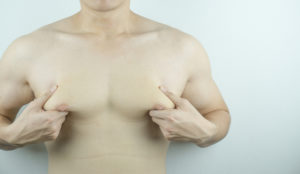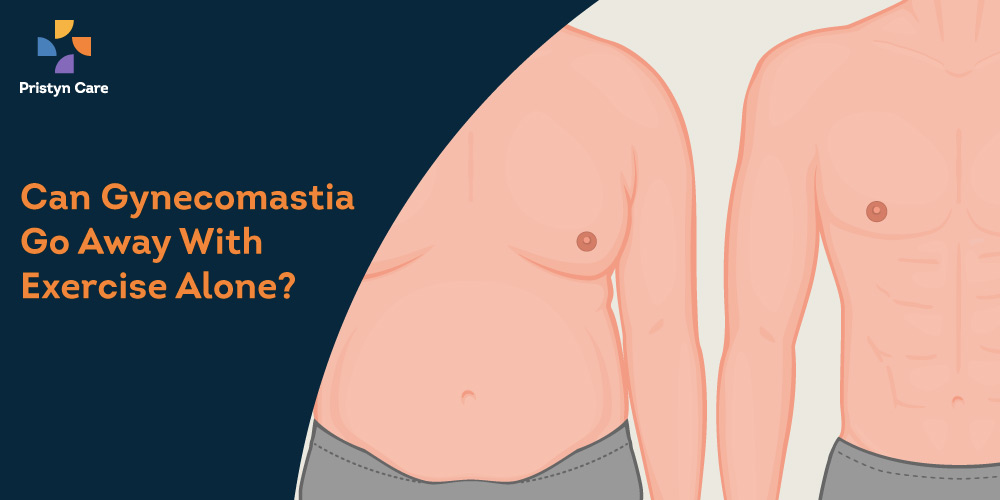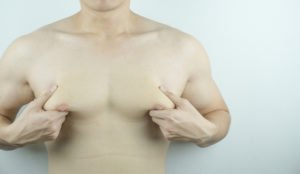If you’ve ever wondered, “Can gynecomastia go away with exercise?” you’re not alone. Gynecomastia, often referred to as “man boobs,” is a condition where men develop excess breast tissue. It can be a source of self-consciousness and discomfort for many individuals. While exercise is often touted as a solution for various health issues, including weight loss and muscle building, the question remains: can exercise help reduce or eliminate gynecomastia? Let’s delve into this topic and explore whether hitting the gym can make a difference.
Before we jump into the details, it’s important to understand that gynecomastia is a complex condition with various underlying causes, such as hormonal imbalances, genetics, medication side effects, or certain medical conditions. While exercise can have positive effects on overall body composition and muscle tone, it may not directly target the underlying breast tissue. However, incorporating regular exercise into your routine can still have a positive impact on your overall physique and self-confidence. So, let’s explore the potential benefits of exercise for individuals dealing with gynecomastia and discover alternative options for addressing this condition.


Can Gynecomastia Go Away With Exercise?
Gynecomastia, commonly referred to as “man boobs,” is a condition characterized by the enlargement of breast tissue in males. It can be caused by hormonal imbalances, certain medications, or underlying medical conditions. Many men who have gynecomastia wonder if exercise can help reduce or eliminate the appearance of their enlarged breasts. While exercise can help improve overall body composition and muscle tone, it may not be enough to completely eliminate gynecomastia. Let’s explore this topic further.
Understanding Gynecomastia
Gynecomastia is a common condition that affects a significant number of men. The development of enlarged breast tissue can be psychologically distressing and may impact self-esteem and body image. It is important to differentiate between true gynecomastia, which involves glandular breast tissue growth, and pseudogynecomastia, which is characterized by an increase in fat deposits in the chest area.
The underlying cause of gynecomastia varies and can include hormonal imbalances, such as an increase in estrogen or a decrease in testosterone levels. This imbalance can be influenced by factors like puberty, aging, obesity, certain medications, or medical conditions like liver disease or testicular tumors. Understanding the cause of gynecomastia is crucial in determining the most effective treatment approach.
Exercise and Gynecomastia
Exercise is an essential component of a healthy lifestyle and can contribute to overall physical fitness. When it comes to gynecomastia, exercise may help in some cases, but it is unlikely to completely eliminate the condition. Regular exercise can help reduce overall body fat percentage, which may lead to a decrease in the size of the breasts. However, it is important to note that gynecomastia involves glandular tissue growth, which cannot be targeted or reduced solely through exercise.
Strength training exercises that target the chest muscles, such as push-ups, chest presses, and dumbbell flyes, can help improve the muscle tone and definition of the chest area. This can create a more sculpted appearance and potentially reduce the prominence of gynecomastia. Additionally, cardiovascular exercises, such as running or cycling, can aid in overall weight loss and contribute to a leaner physique.
While exercise can be beneficial for individuals with gynecomastia, it is essential to manage expectations. It is unlikely that exercise alone will completely eliminate the condition, especially if it is caused by hormonal imbalances or underlying medical conditions. Consulting with a healthcare professional is recommended to determine the most appropriate treatment approach for gynecomastia.
Treatment Options for Gynecomastia
While exercise may not be a definitive solution for gynecomastia, there are other treatment options available. The choice of treatment depends on the underlying cause and the severity of the condition. Some common treatment approaches include:
1. Medications
In certain cases, medications may be prescribed to address the hormonal imbalances associated with gynecomastia. These medications can help reduce estrogen levels or increase testosterone levels, which may lead to a decrease in breast tissue size. However, medication should only be taken under the guidance and supervision of a healthcare professional.
2. Surgery
For individuals with severe or persistent gynecomastia, surgical intervention may be recommended. The two primary surgical options for gynecomastia are liposuction and glandular tissue excision. Liposuction involves the removal of excess fat from the chest area, while glandular tissue excision involves the direct excision of glandular breast tissue. These surgical procedures can provide more immediate and noticeable results compared to exercise alone.
3. Lifestyle Changes
In some cases, gynecomastia may be improved by making certain lifestyle changes. Maintaining a healthy diet, exercising regularly, and avoiding substances that may contribute to hormonal imbalances, such as alcohol or certain medications, can help manage the condition. However, lifestyle changes alone may not be sufficient for significant reduction in gynecomastia.
Conclusion
While exercise can help improve overall body composition and muscle tone, it may not be enough to completely eliminate gynecomastia. Gynecomastia involves the growth of glandular breast tissue, which cannot be targeted or reduced solely through exercise. Other treatment options, such as medications or surgery, may be necessary to achieve significant reduction or elimination of gynecomastia. It is important to consult with a healthcare professional to determine the most appropriate treatment approach based on individual circumstances.
Key Takeaways: Can Gynecomastia Go Away With Exercise?
- Exercise alone may not completely eliminate gynecomastia, but it can help reduce the appearance of the condition.
- Combining cardiovascular exercises with strength training can be beneficial in reducing excess chest fat and building muscle.
- Targeted chest exercises like push-ups and chest presses can help strengthen the chest muscles and improve posture.
- A balanced diet and overall weight loss can contribute to reducing gynecomastia.
- It’s important to consult with a healthcare professional to determine the underlying cause of gynecomastia and develop an appropriate treatment plan.
Frequently Asked Questions
1. Can exercise alone help get rid of gynecomastia?
Exercise can play a role in reducing the appearance of gynecomastia, but it may not make it go away completely. Gynecomastia is caused by an imbalance of hormones, specifically an increase in estrogen or a decrease in testosterone. While exercise can help in reducing overall body fat and improving muscle tone, it may not directly target the breast tissue affected by gynecomastia.
However, incorporating exercises that target the chest muscles, such as push-ups, chest presses, and dumbbell flyes, can help strengthen the chest muscles and improve the overall appearance of the chest. It is important to note that gynecomastia is a medical condition, and it is recommended to consult with a healthcare professional for a comprehensive treatment plan.
2. What role does exercise play in managing gynecomastia?
Exercise can be beneficial in managing gynecomastia by promoting overall weight loss and reducing body fat. Since gynecomastia is often associated with excess fat deposits in the chest area, engaging in regular cardiovascular exercises, such as running, cycling, or swimming, can help burn calories and reduce overall body fat.
In addition, strength training exercises that target the chest muscles can help improve muscle tone and definition. This can help create a more balanced and sculpted appearance of the chest. However, it is important to note that exercise alone may not be sufficient to completely eliminate gynecomastia, especially if the underlying hormonal imbalance is not addressed.
3. Are there any specific exercises that can help reduce gynecomastia?
While exercise cannot directly target the breast tissue affected by gynecomastia, there are certain exercises that can help strengthen the chest muscles and improve the overall appearance of the chest. These exercises include push-ups, chest presses, dumbbell flyes, and cable chest flyes.
It is important to perform these exercises with proper form and technique to maximize their effectiveness. Incorporating a combination of cardiovascular exercises for overall weight loss and strength training exercises for chest muscle development can help in managing gynecomastia.
4. Can losing weight through exercise help reduce gynecomastia?
Losing weight through exercise can potentially help reduce the appearance of gynecomastia, especially if excess body fat is contributing to the condition. Engaging in regular cardiovascular exercises, such as jogging, cycling, or swimming, can help burn calories and promote weight loss.
However, it is important to note that gynecomastia can also be caused by hormonal imbalances, and losing weight alone may not completely eliminate the condition. If hormonal factors are involved, it is recommended to consult with a healthcare professional for a comprehensive treatment plan.
5. Is exercise alone enough to get rid of gynecomastia?
Exercise alone may not be enough to completely get rid of gynecomastia, especially if the underlying cause is hormonal imbalance. Gynecomastia can be caused by factors such as puberty, hormonal medications, or certain medical conditions.
If exercise and lifestyle changes do not lead to a significant reduction in gynecomastia, it is recommended to consult with a healthcare professional. They can assess the underlying cause and recommend appropriate treatment options, which may include medication, hormone therapy, or surgery, in some cases.


Can Gynecomastia be corrected with chest exercises or breast reduction pill? – Dr. Surindher D S A
Final Thoughts
After exploring the question, “Can Gynecomastia Go Away With Exercise?” it is clear that exercise alone may not be enough to completely eliminate gynecomastia. While exercise can certainly help in reducing the appearance of enlarged male breasts, it is important to understand that gynecomastia is often caused by hormonal imbalances or excess glandular tissue, which cannot be targeted solely through exercise.
However, incorporating regular exercise into your routine can still be beneficial for overall body composition and self-confidence. Exercise can help to reduce body fat, which may contribute to a decrease in the size of the breasts. Additionally, strength training exercises that target the chest muscles can help to improve posture and create a more defined chest appearance.
In conclusion, while exercise can play a role in minimizing the effects of gynecomastia, it is essential to consult with a healthcare professional to determine the underlying cause and explore appropriate treatment options. Remember, a comprehensive approach that combines exercise, healthy eating, and medical intervention, if necessary, is often the most effective way to address gynecomastia and achieve the desired results.

